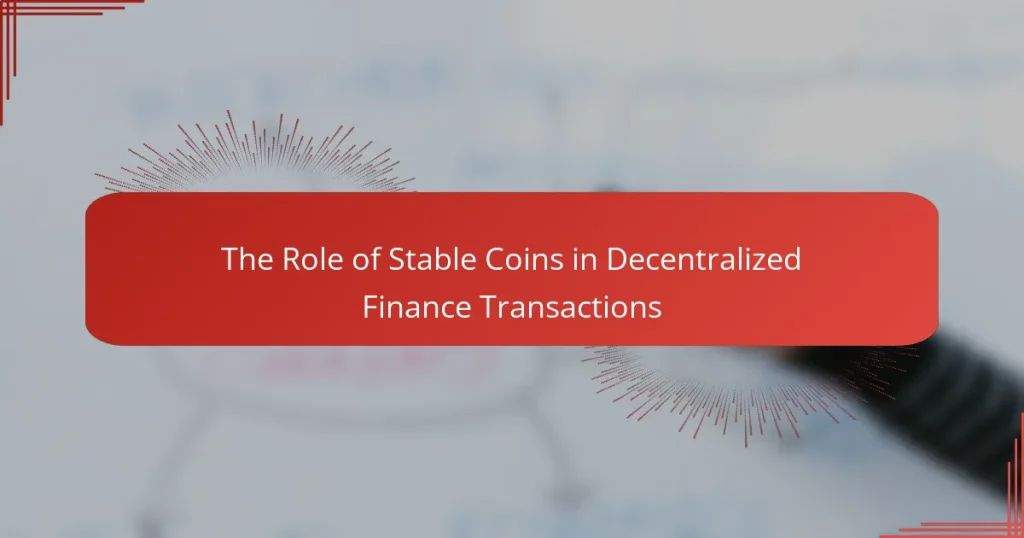Stable coins are integral to decentralized finance (DeFi) transactions, offering a stable value that reduces volatility and facilitates smooth trading and lending. By bridging traditional currencies and cryptocurrencies, they enable users to participate in financial activities while minimizing the risks tied to price fluctuations.
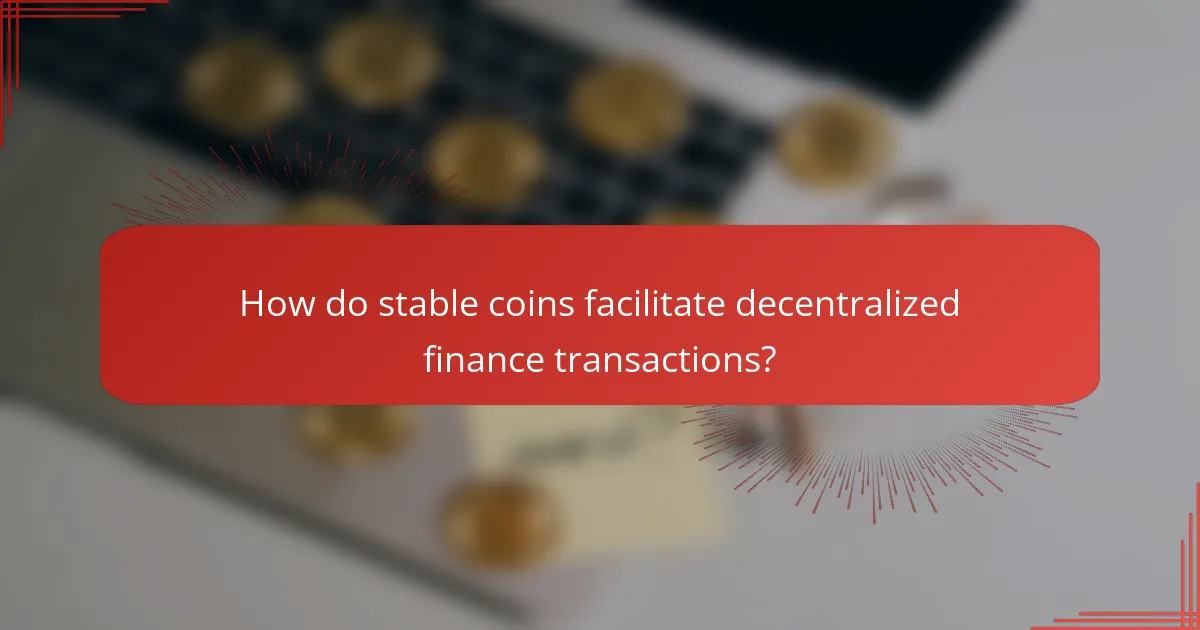
How do stable coins facilitate decentralized finance transactions?
Stable coins play a crucial role in decentralized finance (DeFi) transactions by providing a stable value that mitigates volatility, enabling seamless trading and lending. They act as a bridge between traditional currencies and cryptocurrencies, allowing users to engage in various financial activities without the risks associated with price fluctuations.
Instant liquidity provision
Stable coins offer instant liquidity in DeFi platforms, allowing users to quickly convert their assets into a stable form without delays. This immediacy is vital for traders and investors who need to respond to market changes rapidly. For instance, a user can swap volatile cryptocurrencies for stable coins within seconds, ensuring they can capitalize on opportunities as they arise.
Reduced volatility risk
One of the primary advantages of using stable coins is their reduced volatility compared to traditional cryptocurrencies. By [censured] their value to stable assets like the US dollar or euro, stable coins help users avoid the drastic price swings often seen in the crypto market. This stability makes them ideal for lending, borrowing, and trading within DeFi ecosystems.
Efficient cross-border payments
Stable coins facilitate efficient cross-border payments by eliminating the need for currency conversion and reducing transaction fees. Users can send stable coins globally at lower costs and with faster settlement times compared to traditional banking systems. This efficiency is particularly beneficial for remittances, where users can save on fees that often exceed 5% of the transaction amount.
Smart contract integration
Stable coins are easily integrated into smart contracts, enhancing their functionality in DeFi applications. Smart contracts can automatically execute transactions based on predefined conditions, using stable coins to ensure predictable outcomes. This integration allows for complex financial products, such as automated market makers and decentralized lending platforms, to operate smoothly.
Enhanced user accessibility
Stable coins improve accessibility for users who may not have access to traditional banking services. By allowing anyone with an internet connection to participate in DeFi, stable coins democratize finance. Users can engage in lending, borrowing, and trading without needing a bank account, making financial services more inclusive.
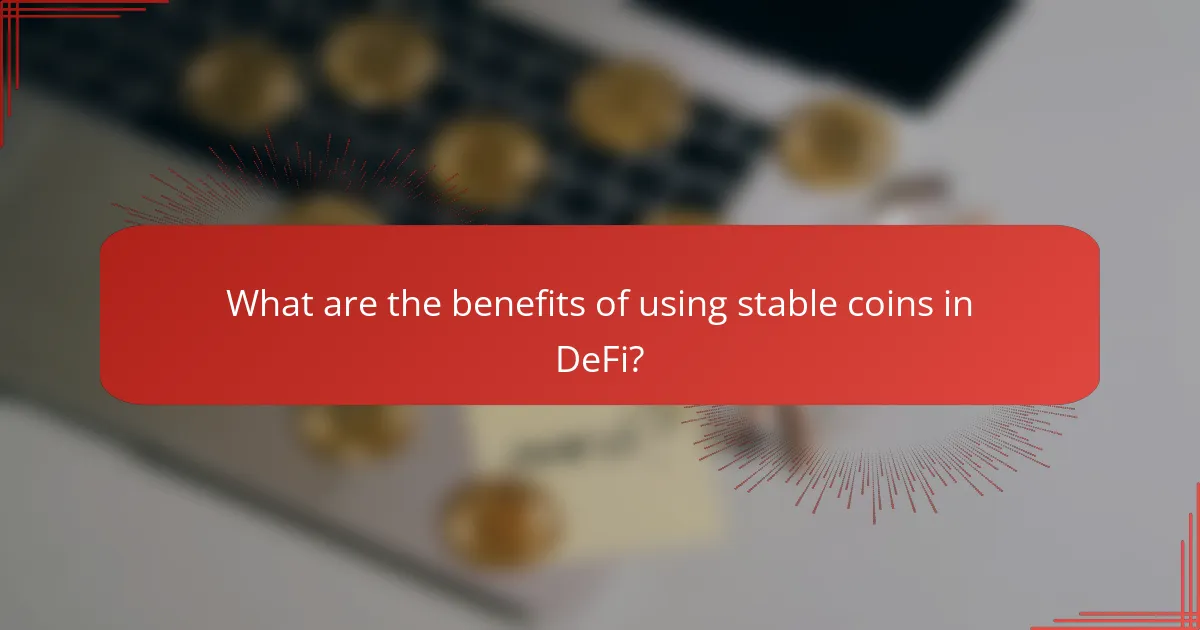
What are the benefits of using stable coins in DeFi?
Stable coins offer several advantages in decentralized finance (DeFi) transactions, primarily through their price stability, lower transaction fees, and ability to attract a broader range of market participants. These features make them an essential tool for users looking to engage in DeFi without the volatility associated with traditional cryptocurrencies.
Price stability
Price stability is one of the main benefits of using stable coins in DeFi. Unlike volatile cryptocurrencies, stable coins are pegged to stable assets, such as the US dollar or other fiat currencies, which helps maintain their value. This stability allows users to transact without worrying about sudden price fluctuations that can occur with other digital assets.
For example, if a user wants to lend or borrow funds in a DeFi platform, using a stable coin ensures that the value of their collateral remains consistent, reducing the risk of liquidation due to market volatility. This predictability is crucial for effective financial planning and risk management.
Lower transaction fees
Stable coins often come with lower transaction fees compared to traditional banking systems and some cryptocurrencies. Since stable coins are designed for efficiency within blockchain ecosystems, users can benefit from reduced costs when transferring funds or executing trades. This is particularly advantageous for smaller transactions, where high fees can significantly impact profitability.
For instance, using stable coins for cross-border payments can save users substantial amounts compared to conventional methods, which may involve high fees and unfavorable exchange rates. This cost-effectiveness encourages more frequent transactions within the DeFi space.
Increased market participation
The use of stable coins in DeFi fosters increased market participation by making it easier for a wider audience to engage with decentralized applications. Individuals who may be hesitant to invest in volatile cryptocurrencies can feel more comfortable using stable coins, knowing their value will not fluctuate dramatically.
This accessibility can lead to greater liquidity in DeFi markets, as more users are willing to lend, borrow, or trade using stable coins. Additionally, stable coins can facilitate participation from institutional investors who require a stable asset for their operations, further enhancing the overall ecosystem.

Which stable coins are most popular in DeFi?
The most popular stable coins in decentralized finance (DeFi) include USDC, DAI, and Tether (USDT). These digital currencies are widely used for transactions, lending, and liquidity provision due to their price stability and ease of integration within various DeFi platforms.
USDC
USDC, or USD Coin, is a fully-backed stable coin pegged to the US dollar, making it a reliable choice for DeFi transactions. Each USDC is backed by one US dollar held in reserve, ensuring transparency and trust through regular audits.
In DeFi, USDC is often used for lending, borrowing, and providing liquidity on decentralized exchanges. Its popularity stems from its regulatory compliance and backing by reputable financial institutions, which adds a layer of security for users.
DAI
DAI is a decentralized stable coin that maintains its value through a system of smart contracts on the Ethereum blockchain. Unlike USDC, DAI is not backed by fiat currency directly but rather by collateralized assets, primarily Ethereum.
DAI is favored in DeFi for its decentralized nature, allowing users to generate DAI by locking up collateral in a MakerDAO vault. This mechanism provides flexibility and autonomy, appealing to users who prioritize decentralization over traditional banking systems.
Tether (USDT)
Tether (USDT) is one of the oldest stable coins, also pegged to the US dollar. It aims to provide stability in the volatile cryptocurrency market by maintaining a 1:1 value with the dollar, backed by reserves that include cash and cash equivalents.
USDT is widely accepted across various DeFi platforms, making it a popular choice for trading and liquidity. However, users should be aware of the ongoing scrutiny regarding Tether’s reserve practices and regulatory compliance, which may affect its long-term reliability in DeFi transactions.
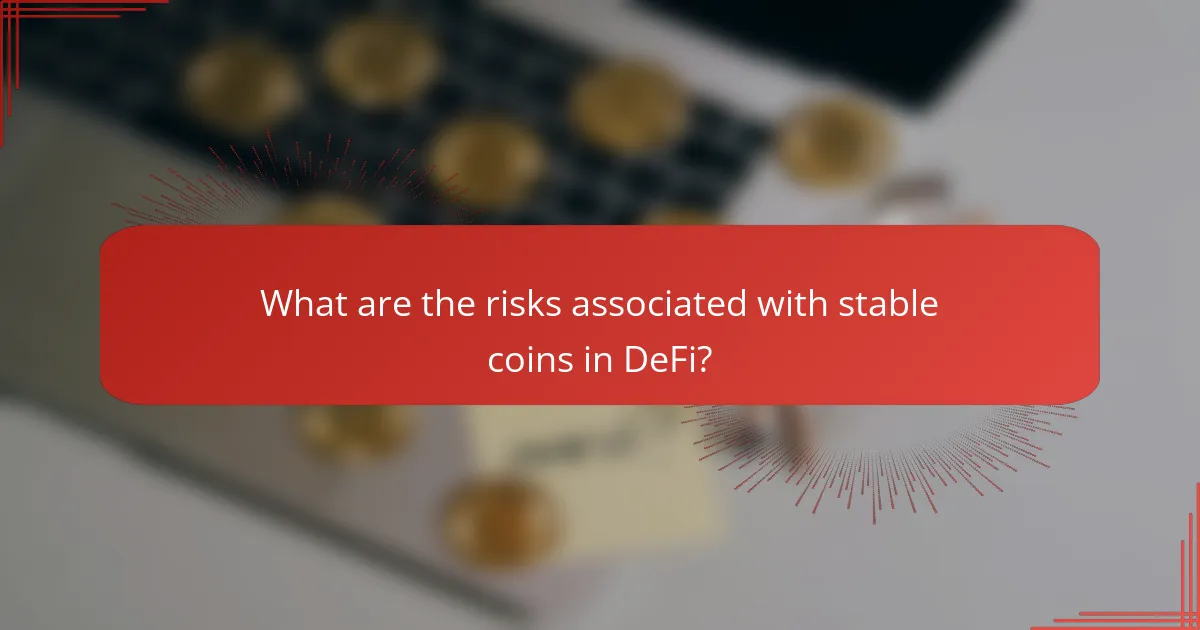
What are the risks associated with stable coins in DeFi?
Stable coins in decentralized finance (DeFi) carry several risks that can impact their reliability and usability. Key concerns include smart contract vulnerabilities, regulatory scrutiny, and centralization issues, all of which can affect the stability and trustworthiness of these digital assets.
Smart contract vulnerabilities
Smart contracts are self-executing contracts with the terms directly written into code. However, they can contain bugs or vulnerabilities that malicious actors might exploit, leading to significant financial losses. For example, a poorly coded smart contract could allow unauthorized access to funds or manipulation of transactions.
To mitigate these risks, users should conduct thorough audits of smart contracts and only interact with projects that have undergone extensive security reviews. Additionally, utilizing platforms with a strong track record of security can help reduce exposure to vulnerabilities.
Regulatory scrutiny
Stable coins face increasing regulatory scrutiny as governments seek to understand their implications on financial systems. Regulations may vary significantly by country, with some jurisdictions imposing strict guidelines on stable coin issuance and usage. This scrutiny can lead to sudden changes in the legal status of certain stable coins, affecting their availability and usability.
Users should stay informed about the regulatory landscape in their region and consider the potential impact of regulations on their stable coin holdings. Engaging with platforms that prioritize compliance can also provide a layer of security against regulatory risks.
Centralization concerns
Many stable coins are backed by centralized entities that control their issuance and redemption processes. This centralization can lead to risks such as lack of transparency and potential manipulation by the issuing organization. For instance, if a stable coin issuer fails to maintain adequate reserves, it could lead to a loss of trust and value in the stable coin.
To address centralization concerns, users should evaluate the backing mechanisms of stable coins and consider diversifying their holdings across multiple stable coins with different backing structures. Opting for decentralized stable coins, when available, can also reduce reliance on centralized entities.
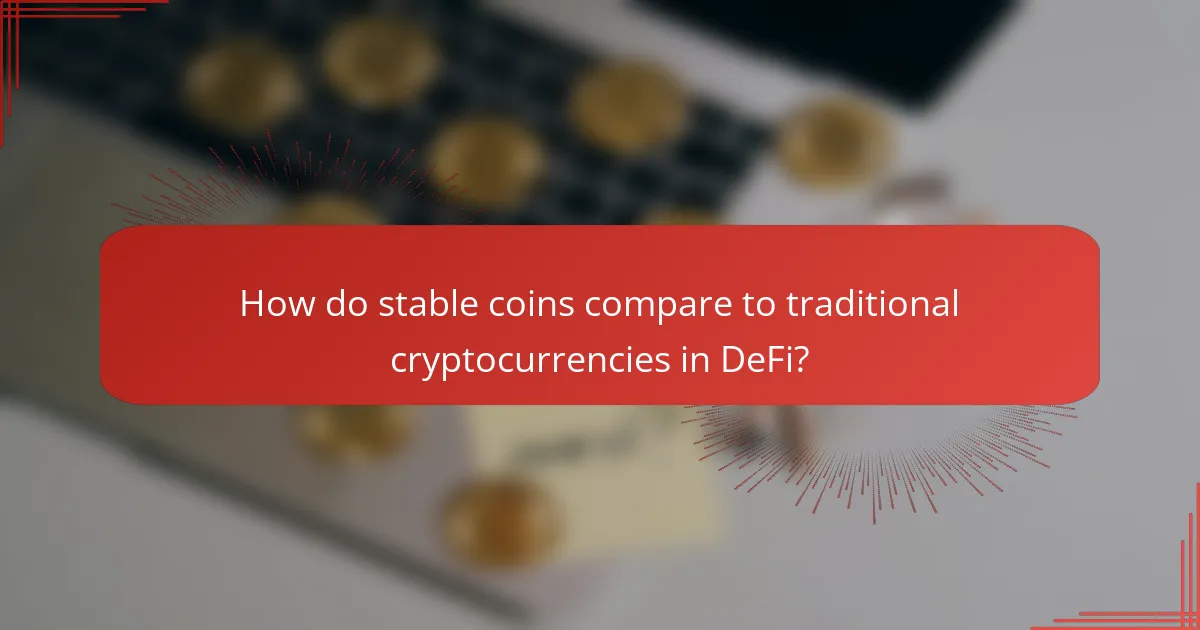
How do stable coins compare to traditional cryptocurrencies in DeFi?
Stable coins are designed to maintain a stable value, making them more suitable for decentralized finance (DeFi) transactions compared to traditional cryptocurrencies, which can experience significant price fluctuations. This stability allows users to engage in lending, borrowing, and trading with reduced risk of value loss.
Lower volatility
Stable coins exhibit lower volatility than traditional cryptocurrencies like Bitcoin or Ethereum, which can swing dramatically in value within short periods. This stability is primarily achieved by [censured] stable coins to a reserve of assets, such as fiat currencies or commodities, which helps maintain their value.
For example, a stable coin pegged to the US dollar typically aims to maintain a 1:1 ratio, meaning one stable coin is worth approximately one dollar. This predictability allows users to transact without the fear of sudden price drops that can occur with more volatile cryptocurrencies.
When using stable coins in DeFi, it’s crucial to choose reputable projects that adhere to transparency and regulatory standards to ensure the backing assets are secure. Avoid platforms with unclear backing mechanisms, as this could lead to unexpected risks.
